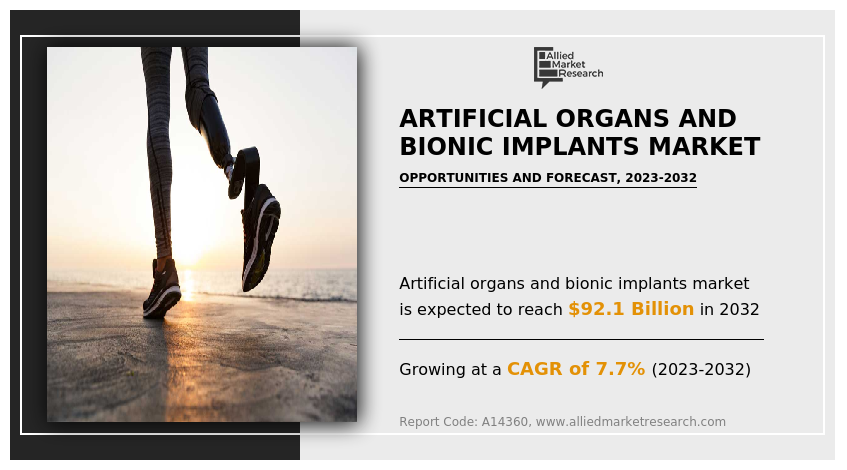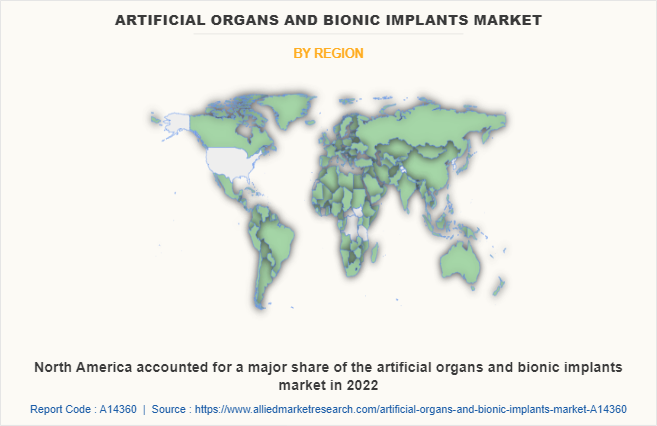
Allied Market Research Unveils Study on Booming $92.1 Billion Artificial Organs and Bionic Implants Market

The global market for artificial organs and bionic implants, which was valued at $44.4 billion in 2022, is anticipated to nearly double, reaching $92.1 billion by 2032. This growth reflects a compound annual growth rate (CAGR) of 7.7% from 2023 to 2032, indicating a robust expansion driven by advancements in medical technology and an increasing demand for life-enhancing medical devices.
Artificial organs and bionic implants are sophisticated medical devices engineered to either replace or enhance the function of natural organs or body parts that are compromised. Utilizing cutting-edge technology and engineering principles, these devices aim to restore or improve bodily functions, thereby enhancing the quality of life for individuals with various medical conditions or disabilities.
Artificial organs are meticulously designed to mimic the structure and function of specific organs within the body. They are entirely man-made and are intended to take over the role of the damaged or missing organ, providing a lifeline for patients in need of organ replacement.
Bionic implants, on the other hand, are advanced electronic or mechanical devices that are integrated into the body to either restore lost functions or provide new capabilities. These implants synergize biological and technological components, interfacing seamlessly with the body’s natural systems to enhance or recover specific functions. This integration of biological and technological elements allows bionic implants to offer therapeutic benefits and augment the body’s natural abilities in ways that were previously unimaginable.
Get a Sample Copy of this Report: https://www.alliedmarketresearch.com/request-sample/A14360
Segmental Overview
The global market for artificial organs and bionic implants is segmented by type, technology, end user, and region.
By Type
The market is divided into orthopedic bionics, ear bionics, and others. The orthopedic bionics segment is further classified into bionic hand, bionic leg, and other devices such as bionic limbs, fingers, and bone growth stimulators. In 2022, the “others” segment generated the most revenue, driven by the high adoption of artificial hearts and penile implants. This segment is also projected to experience the highest CAGR during the forecast period due to the increasing prevalence of heart disease and ongoing research into bionic eye and brain implants.
By Technology
The technology segment splits into electronic and mechanical categories. The electronic segment led the market in 2022 and is expected to grow at the highest CAGR during the forecast period. This dominance is attributed to the high adoption rates of electronic artificial organs and bionic implants, increasing demand for electronic bionic devices, and a surge in clinical trials for these implants.
By End User
The end user segment includes hospitals, ambulatory surgical centers, and others, such as clinics, transplant research centers, and academic institutes. Hospitals held the largest market share in 2022, driven by the high demand for artificial organs and bionic implants and the volume of surgical procedures performed in these settings. Ambulatory surgical centers are anticipated to exhibit the highest CAGR due to their growing numbers in developed countries and rising awareness in developing nations like China and India.

By Region
- North America: Dominated the market in 2022 and is expected to maintain its lead due to the presence of major industry players, a high number of clinical trials, advanced healthcare facilities, significant government healthcare expenditure, and a strong reimbursement framework. The U.S. is a major contributor to the regional market’s growth, with high rates of heart disease, substantial purchasing power, and increased adoption of artificial organs and bionic implants.
- Europe: Significant markets include Germany, France, the UK, Italy, and Spain, with robust healthcare systems and ongoing research and development activities in the field.
- Asia-Pacific: Expected to grow at the highest rate during the forecast period due to rising road accidents and injuries, increasing purchasing power in countries like China and India, and a large population base. This region’s growth is also fueled by a longer life expectancy and a growing awareness of advanced medical technologies.
- LAMEA: Includes Brazil, South Africa, Saudi Arabia, and other regions, where market growth is supported by improving healthcare infrastructure and increasing healthcare investments.
Competition Analysis
Major players in the artificial organs and bionic implants market include:
- Abbott Laboratories
- Berlin Heart GmbH
- Boston Scientific Corporation
- Cochlear Limited
- Edwards Lifesciences Corporation
- Jarvik Heart, Inc.
- Johnson & Johnson
- Medtronic plc
- SynCardia Systems, LLC
- Zimmer Biomet Holding Inc.
These companies employ strategies such as agreements, acquisitions, product approvals, and launches to enhance their market presence and product portfolios.
Recent Developments
Acquisitions
- In December 2022, Johnson & Johnson completed its acquisition of Abiomed, Inc., which now operates as a standalone business within Johnson & Johnson’s MedTech segment.
- In September 2021, Picard Medical, a portfolio company of Hunniwell Lake Ventures, acquired SynCardia Systems, LLC.
Agreements
- In April 2023, Picard Medical, Inc. announced a business combination agreement with Altitude Acquisition Corp., resulting in Picard Medical becoming a publicly listed company on Nasdaq.
Product Approvals
- In December 2022, the FDA approved Abiomed’s (now Johnson & Johnson) Impella ECP for its pivotal trial.
- In October 2022, the FDA granted pre-market approval for Abiomed’s Impella RP Flex with SmartAssist.
- In January 2022, Abiomed received various regulatory approvals in the U.S. and Asia for its Impella surgical products, including the Impella BTR, Impella 5.5 with SmartAssist, and others.
Editor Details
-
Company:
- The Wire Times
